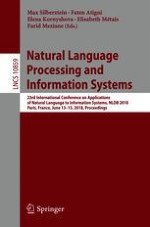2018 | Buch
Natural Language Processing and Information Systems
23rd International Conference on Applications of Natural Language to Information Systems, NLDB 2018, Paris, France, June 13-15, 2018, Proceedings
herausgegeben von: Max Silberztein, Faten Atigui, Elena Kornyshova, Elisabeth Métais, Farid Meziane
Verlag: Springer International Publishing
Buchreihe : Lecture Notes in Computer Science
